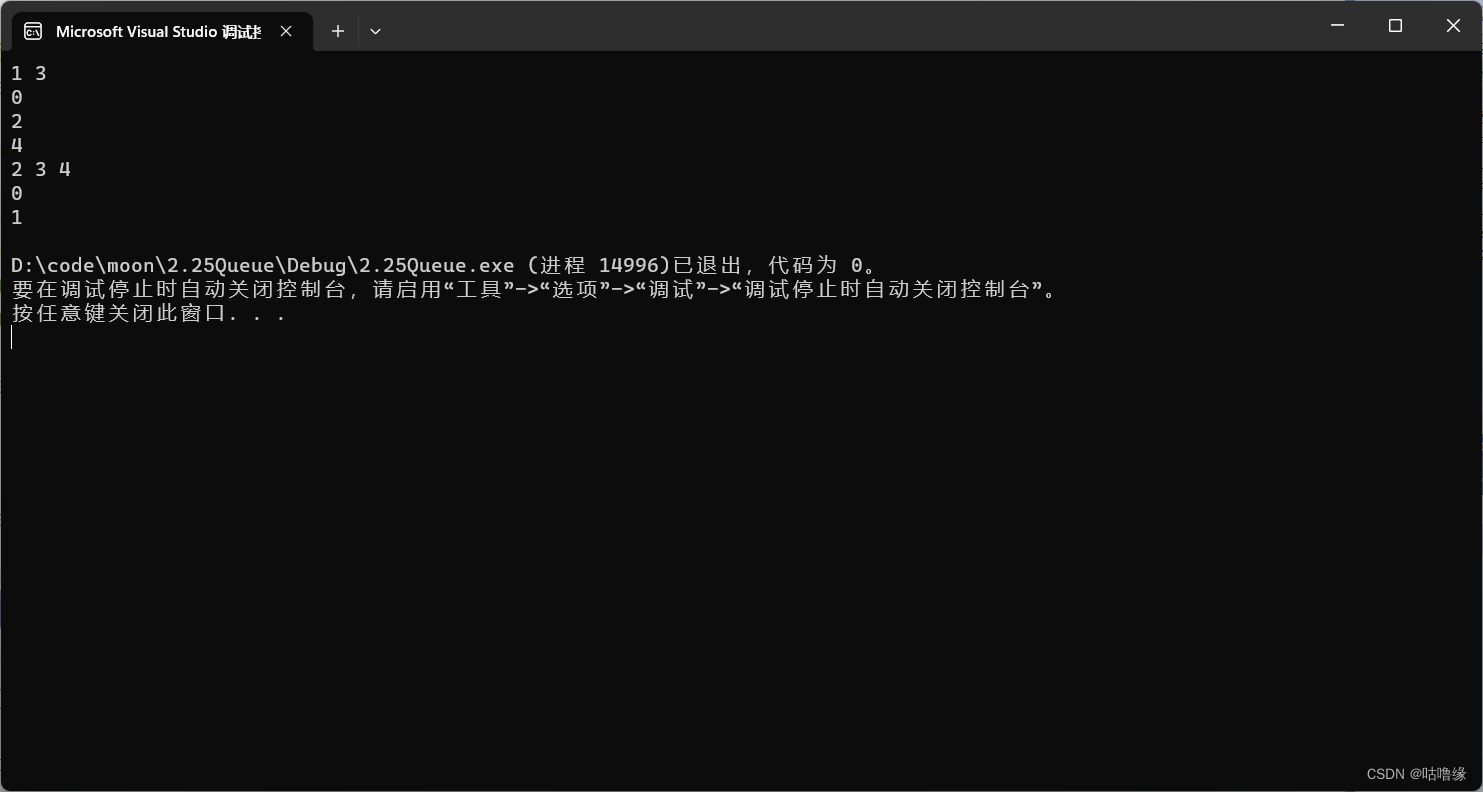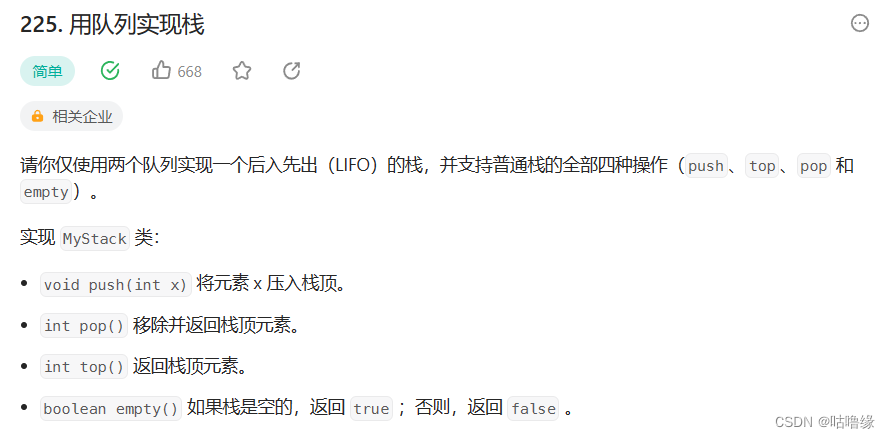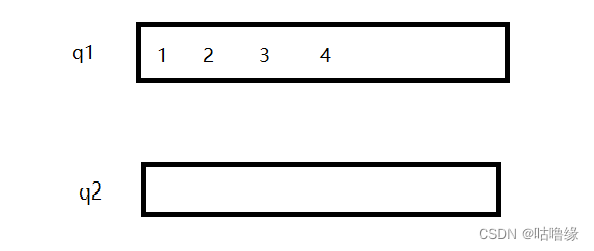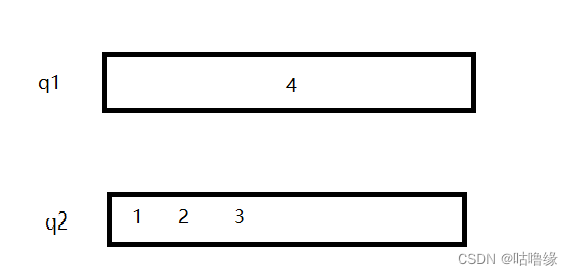1.队列的概念和结构
队列:只允许在一端进行插入数据操作,在另一端进行删除数据操作的特殊线性表,队列具有先进先出FIFO(First In First Out) 入队列:进行插入操作的一端称为队尾 出队列:进行删除操作的一端称为队头

2.队列的实现(链表实现)
2.1函数头文件(函数声明)
#define _CRT_SECURE_NO_WARNINGS 1
#pragma once
#include<stdio.h>
#include<stdlib.h>
#include<stdbool.h>
#include<assert.h>
typedef int QDataType;
typedef struct QueueNode
{
QDataType data;
struct QueueNode* next;
}QNode;
typedef struct Queue
{
QNode* head;
QNode* tail;
int size;
}Queue;
void QueueInit(Queue* pq);
void QueueDestroy(Queue* pq);
void QueuePush(Queue* pq, QDataType x);
void QueuePop(Queue* pq);
QDataType QueueFront(Queue* pq);
QDataType QueueBack(Queue* pq);
bool QueueEmpty(Queue* pq);
int QueueSize(Queue* pq);
2.2函数实现
#include"Queue.h"
void QueueInit(Queue* pq)
{
assert(pq);
pq->head = NULL;
pq->tail = NULL;
pq->size = 0;
}
void QueueDestroy(Queue* pq)
{
assert(pq);
QNode* cur = pq->head;
while (cur)
{
QNode* del = cur;
cur = del->next;
free(del);
}
pq->head = NULL;
pq->tail = NULL;
pq->size = 0;
}
void QueuePush(Queue* pq, QDataType x)
{
assert(pq);
QNode* newnode = (QNode*)malloc(sizeof(QNode));
if (newnode == NULL)
{
perror("malloc fail");
exit(-1);
}
newnode->data = x;
newnode->next = NULL;
if (pq->head== NULL)
{
pq->head =pq->tail= newnode;
}
else
{
pq->tail->next = newnode;
pq->tail = newnode;
}
pq->size++;
}
void QueuePop(Queue* pq)
{
assert(pq);
assert(!QueueEmpty(pq));
if (pq->head->next == NULL)
{
free(pq->head);
pq->head =pq->tail= NULL;
}
else
{
QNode* cur = pq->head->next;
free(pq->head);
pq->head = cur;
}
pq->size--;
}
QDataType QueueFront(Queue* pq)
{
assert(pq);
assert(!QueueEmpty(pq));
return pq->head->data;
}
QDataType QueueBack(Queue* pq)
{
assert(pq);
assert(!QueueEmpty(pq));
return pq->tail->data;
}
bool QueueEmpty(Queue* pq)
{
assert(pq);
return pq->head==NULL&& pq->tail==NULL;
}
int QueueSize(Queue* pq)
{
assert(pq);
return pq->size;
}
2.3函数测试
#define _CRT_SECURE_NO_WARNINGS 1
#include"Queue.h"
testQueue()
{
Queue q;
QueueInit(&q);
QueuePush(&q, 1);
QueuePush(&q, 2);
printf("%d ", QueueFront(&q));
QueuePop(&q);
QueuePush(&q, 3);
QueuePush(&q, 4);
printf("%d\n", QueueSize(&q));
printf("%d\n", QueueEmpty(&q));
printf("%d\n", QueueFront(&q));
printf("%d\n", QueueBack(&q));
while (!QueueEmpty(&q))
{
printf("%d ", QueueFront(&q));
QueuePop(&q);
}
printf("\n");
printf("%d\n", QueueSize(&q));
printf("%d\n", QueueEmpty(&q));
//printf("%d\n", QueueFront(&q));
//printf("%d\n", QueueBack(&q));
QueueDestroy(&q);
}
int main()
{
testQueue();
}

3.用队列实现栈

3.1思路分析

首先我们先要对栈和队列的定义分清楚
队列 先进先出
栈 先进后出

假设q1有 1 2 3 4
我们对他进行出栈应该是4但是我们如何用出队方式实现呢?

int myStackPop(MyStack* obj) {
Queue*empty=&obj->q1;
Queue*noempty=&obj->q2;
if(!QueueEmpty(&obj->q1))
{
empty=&obj->q2;
noempty=&obj->q1;
}
while(QueueSize(noempty)>1)
{
QueuePush(empty,QueueFront(noempty));
QueuePop(noempty);
}
int top=QueueFront(noempty);
QueuePop(noempty);
return top;
}
上述方法就是非空队列不断出队直到剩一个,将元素保存至空队列,然后将非空队列省的最后一个元素出队出队
从上述思路得知我们最重要的就是对空队列的判断
2.1代码实现
#include<stdio.h>
#include<stdlib.h>
#include<stdbool.h>
#include<assert.h>
typedef int QDataType;
typedef struct QueueNode
{
QDataType data;
struct QueueNode* next;
}QNode;
typedef struct Queue
{
QNode* head;
QNode* tail;
int size;
}Queue;
void QueueInit(Queue* pq);
void QueueDestroy(Queue* pq);
void QueuePush(Queue* pq, QDataType x);
void QueuePop(Queue* pq);
QDataType QueueFront(Queue* pq);
QDataType QueueBack(Queue* pq);
bool QueueEmpty(Queue* pq);
int QueueSize(Queue* pq);
void QueueInit(Queue* pq)
{
assert(pq);
pq->head = NULL;
pq->tail = NULL;
pq->size = 0;
}
void QueueDestroy(Queue* pq)
{
assert(pq);
QNode* cur = pq->head;
while (cur)
{
QNode* del = cur;
cur = del->next;
free(del);
}
pq->head = NULL;
pq->tail = NULL;
pq->size = 0;
}
void QueuePush(Queue* pq, QDataType x)
{
assert(pq);
QNode* newnode = (QNode*)malloc(sizeof(QNode));
if (newnode == NULL)
{
perror("malloc fail");
exit(-1);
}
newnode->data = x;
newnode->next = NULL;
if (pq->head== NULL)
{
pq->head =pq->tail= newnode;
}
else
{
pq->tail->next = newnode;
pq->tail = newnode;
}
pq->size++;
}
void QueuePop(Queue* pq)
{
assert(pq);
assert(!QueueEmpty(pq));
if (pq->head->next == NULL)
{
free(pq->head);
pq->head =pq->tail= NULL;
}
else
{
QNode* cur = pq->head->next;
free(pq->head);
pq->head = cur;
}
pq->size--;
}
QDataType QueueFront(Queue* pq)
{
assert(pq);
assert(!QueueEmpty(pq));
return pq->head->data;
}
QDataType QueueBack(Queue* pq)
{
assert(pq);
assert(!QueueEmpty(pq));
return pq->tail->data;
}
bool QueueEmpty(Queue* pq)
{
assert(pq);
return pq->head==NULL&& pq->tail==NULL;
}
int QueueSize(Queue* pq)
{
assert(pq);
return pq->size;
}
typedef struct {
Queue q1;
Queue q2;
} MyStack;
//正文开始
MyStack* myStackCreate() {
MyStack*obj=(MyStack*)malloc(sizeof(MyStack));
QueueInit(&obj->q1);
QueueInit(&obj->q2);
return obj;
}
void myStackPush(MyStack* obj, int x)
{
if(!QueueEmpty(&obj->q1))
{
QueuePush(&obj->q1,x);
}
else
QueuePush(&obj->q2,x);
}
int myStackPop(MyStack* obj) {
Queue*empty=&obj->q1;
Queue*noempty=&obj->q2;
if(!QueueEmpty(&obj->q1))
{
empty=&obj->q2;
noempty=&obj->q1;
}
while(QueueSize(noempty)>1)
{
QueuePush(empty,QueueFront(noempty));
QueuePop(noempty);
}
int top=QueueFront(noempty);
QueuePop(noempty);
return top;
}
int myStackTop(MyStack* obj) {
if(!QueueEmpty(&obj->q1))
{
return QueueBack(&obj->q1);
}
else
{
return QueueBack(&obj->q2);
}
}
bool myStackEmpty(MyStack* obj) {
return QueueEmpty(&obj->q1)&&QueueEmpty(&obj->q2);
}
void myStackFree(MyStack* obj) {
QueueDestroy(&obj->q1);
QueueDestroy(&obj->q2);
free(obj);
}






















 210
210











 被折叠的 条评论
为什么被折叠?
被折叠的 条评论
为什么被折叠?








